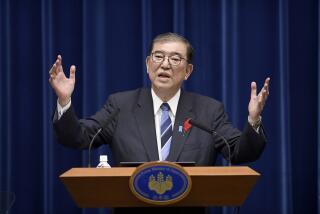Japan Enacts Final Political Reform Laws : Asia: The legislation creates 300 single-seat Parliament districts. Changes aimed at producing a two-party system, cutting corruption.
- Share via
TOKYO — Concluding a six-year struggle under seven prime ministers, Japan’s Parliament on Monday voted into law the final pieces of political reforms designed to produce a two-party system, campaigns fought on policy issues rather than pork-barrel handouts and periodic changes of government.
Socialist Prime Minister Tomiichi Murayama, however, said the vote marked “just the start of political reform.”
The form of “a saint has emerged but it has no soul yet. We must transform (the laws) into a force that will restore the people’s confidence (in politics),” he said.
Three bills drawing boundaries for 300 single-seat lower house districts, stiffening penalties for vote buying and fixing qualifications of parties eligible to share $309 million in government campaign subsidies passed the upper house in a nearly unanimous vote.
The subsidies, equal to $2.50 for each voter, will be given to parties for the first time in proportion to their holdings in Parliament, in the hope of reducing corruption stemming from reliance upon donations from special interest groups.
Coupled with reforms passed in March under former Prime Minister Morihiro Hosokawa, the new laws, which go into effect Dec. 25, will end a 70-year-old system of multi-seat districts with an average of four representatives, some of whom polled less than 20% of the total vote. Two hundred other seats will be filled through a proportional representation system, in which voters cast a second ballot for the party of their choice.
Spurred by a 1988-89 stocks-for-favors scandal that tainted all of the leaders of the then-ruling Liberal Democratic Party, efforts to carry out reform were thwarted repeatedly until an intraparty rebellion deprived Japan’s perennial rulers of their 38-year grasp on power and brought a reform coalition under Hosokawa to power in August, 1993.
Even then, rebels within the ranks of Hosokawa’s supporters once again defeated reforms in an upper house vote in January. A last-minute compromise, however, won Liberal Democrat support and brought about enactment in March. Bills passed Monday filled in the details of those laws.
When the new electoral system will be put to a test remains unknown.
Former Prime Minister Tsutomu Hata called for elections early next year, but Murayama said he was not thinking of dissolving the lower house, whose term runs through July, 1997.
Under the new system, the next election is certain to create an upheaval. NHK, the semi-governmental radio and TV network, reported that politicians belonging to the Liberal Democrat, Socialist and Harbinger parties in Murayama’s coalition already are battling each other in unofficial campaigning in 131 of the 300 new single-seat districts. Forty-eight of those battles pit Liberal Democrats against Liberal Democrats.
Members of eight parties that supported the former coalition governments of Hosokawa and Hata--who have pledged to form a single unified opposition group Dec. 10--are doubled up against each other in 44 districts, NHK said.
As a result of the intense competition, major aims of the reforms--to slash electioneering costs and to force one-on-one battles focusing on party policy--appeared unlikely to be realized.
Commentators predicted that at least two or three elections would be needed to reduce the current field of more than a dozen parties to two major groups, each capable of running a government--if indeed a weeding-out proves possible.
Already, 40 rebels in the ranks of Murayama’s own Socialists have declared their intention to set themselves apart from the Liberal Democrats and the Hosokawa-Hata group--both of which are conservative blocks--by establishing a third “liberal force.”
Such a rebellion would deprive the Murayama coalition of a majority in the lower house. A walkout of that scope, however, was unlikely.
In July, Murayama abandoned more than four decades of Socialist pacifist ideology, declaring Japan’s armed forces constitutional and supporting the U.S.-Japan Security Treaty. Since then, both the ruling coalition and the opposition have been struggling to find new policies with which to distinguish themselves in appealing to voters.
More to Read
Sign up for Essential California
The most important California stories and recommendations in your inbox every morning.
You may occasionally receive promotional content from the Los Angeles Times.













